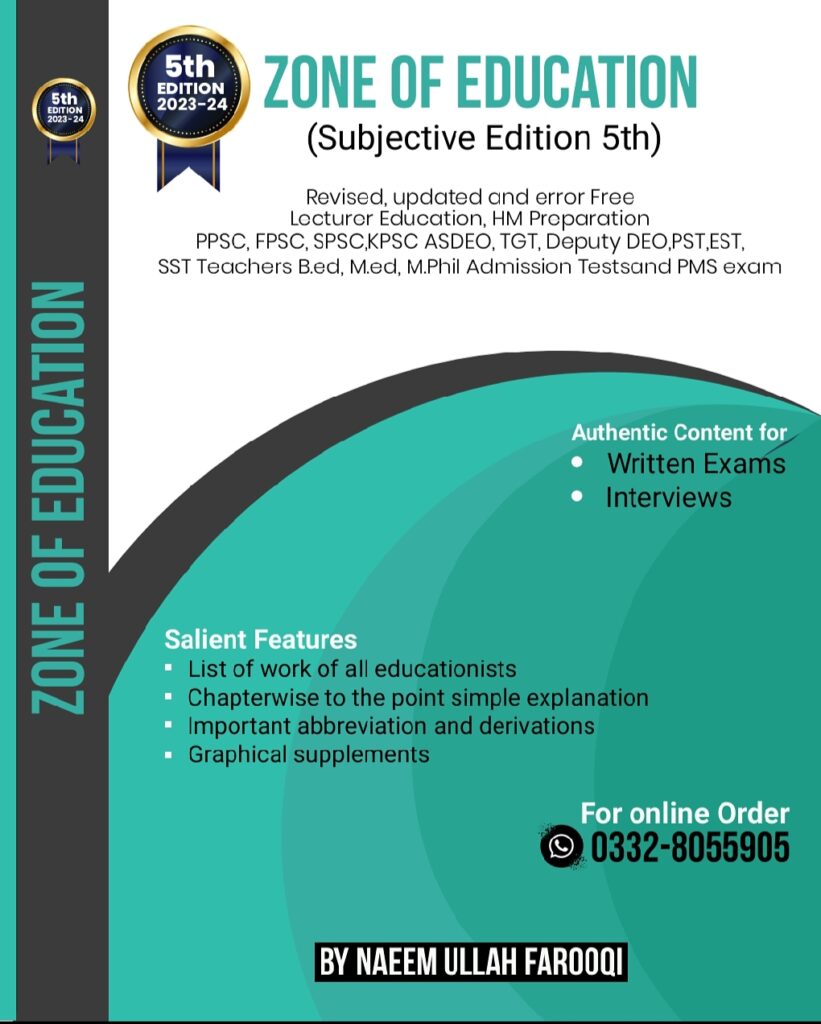Psychology
Bandura’s research showed that people are more likely to copy behavior that they expect will lead to:
· A. Positive Role
· B. Positive outcome
· C. Negative Role
· D. None of the above
Ans: (B) Positive outcome
107. Children were shown a film, and afterward, they performed the same action in an experiment by Albert Bandura. This experiment became famous with the name of:
· A. Bobo doll experiment
· B. Barbie doll experiment
· C. Marry doll experiment
· D. None of the above
Ans: (A) Bobo doll experiment
108. Alfred Binet is best remembered as the developer of:
· A. Conditioning experiments
· B. Behaviourist Psychology
· C. Behaviourist theory
· D. Intelligence Test
Ans: (D) Intelligence Test
109. Along with Théodore Simon, Binet developed the:
· A. Binet-Theodore scale
· B. Binet-Simon Scale
· C. Both A & B
· D. None of the above
Ans: (B) Binet-Simon Scale
110. Binet’s ideas about intelligence were rooted in his earlier theory of:
· A. Learning psychology
· B. Individual learning
· C. Individual psychology
· D. None of the above
Ans: (C) Individual psychology
111. Binet believed that intelligence was not a single entity. Instead, he viewed it as:
· A. Collection of specific processes
· B. Collection of different ideas
· C. Collection of multiple factors
· D. None of the above
Ans: (A) Collection of specific processes
112. According to Binet, intelligence is:
· A. Fixed
· B. Changeable without any limits
· C. Changeable within limits
· D. None of the above
Ans: (C) Changeable within limits
113. Binet termed the fixed or set intelligence opinion of the psychologists as:
· A. Actual pessimism
· B. Brutal pessimism
· C. Brutal analysis
· D. None of the above
Ans: (B) Brutal pessimism
114. Binet argued that his test avoided:
· A. Biasness
· B. Inconsistency
· C. Subjectivity
· D. All of the above
Ans: (D) All of the above
115. The Binet-Simon scale was first introduced in:
· A. 1903
· B. 1904
· C. 1905
· D. 1906
Ans: (C) 1905
116. Amongst his greatest achievements, Freud changed the way society has come to think about and treat:
· A. Physical illness
· B. Critical illness
· C. Mental illness
· D. None of the above
Ans: (C) Mental illness
117. Freud believed that human behaviors are mostly controlled by:
· A. Conscious ideas and thoughts
· B. Unconscious thinking
· C. Unconscious motives and drives
· D. Conscious motives and drives
Ans: (C) Unconscious motives and drives
118. Freud is famous for it was he who actually developed and repeatedly revised his theory of:
· A. Psychoanalysis
· B. Psychosocial analysis
· C. Intelligent design
· D. None of the above
Ans: (A) Psychoanalysis
119. Freud hypothesized that the mind is divided into three main parts:
· A. The consciousness, Unconsciousness, and subconscious
· B. The unconscious, the conscious, and the preconscious
· C. The conscious, the unconscious, and preconscious
· D. All of the above
Ans: (B) The unconscious, the conscious, and the preconscious
120. Freud created the techniques of psychoanalysis as the means of bringing material from the:
· A. Unconscious to preconscious mind
· B. Unconscious to subconscious mind
· C. Unconscious into the conscious mind
· D. Conscious to unconscious mind
Ans: (C) Unconscious into the conscious mind
121. In Freud’s theory of personality:
· A. The ego obeys the reality principle
· B. The id operates by secondary process thinking
· C. The super-ego obeys the pleasure principle
· D. None of these
Ans: (A) The ego obeys the reality principle
122. According to Freudian dream terminology, condensation refers to:
· A. Repressed urges that find disguised outlets for expression
· B. The bizarre, irrational quality of dreams
· C. The process whereby unacceptable thoughts or impulses are combined into a single dream image
· D. The process whereby one thing may stand for another in dream interpretation
Ans: (A) Repressed urges that find disguised outlets for expression
123. Lawrence Kohlberg, although a psychologist, is more regarded as a leader in the field of:
· A. Curriculum education
· B. Psychoanalysis
· C. Moral education
· D. Physical education
Ans: (C) Moral education
124. Kohlberg worked out an approach to moral development known as:
· A. Cognitive structuralism
· B. Affective structuralism
· C. Cognitive psychology
· D. None of the above
Ans: (A) Cognitive structuralism
125. The cognitive structuralism approach of Kohlberg focuses on the growing child’s processes of:
· A. Logical reasoning
· B. Sequential reasoning
· C. Moral reasoning
· D. Mental reasoning
Ans: (C) Moral reasoning
126. Kohlberg and his followers regard children as independent agents capable of thinking for themselves about:
· A. Social issues
· B. Moral issues
· C. Psychological issues
· D. None of the above
Ans: (B) Moral issues
127. The theory of cognitive structuralism or developmentalism is contrasted with the:
· A. Freudian view of moral development
· B. Behaviourist view of moral development
· C. Both A & B
· D. None of the above
Ans: (C) Both A & B
128. Kohlberg is best known for his theory known as:
· A. Cage theory
· B. Stage theory
· C. Stage and backstage theory
· D. None of the above
Ans: (B) Stage theory
129. Kohlberg divided his stages of moral development across three levels, with:
· A. Two stages at each level
· B. Three stages at each level
· C. Four stages at each level
· D. Six stages at each level
Ans: (a) Two stages at each level
130. Abraham Maslow is considered one of the founding fathers of:
· A. Socialistic psychology
· B. Pluralistic psychology
· C. Naturalistic psychology
· D. Humanistic psychology
Ans: (D) Humanistic psychology
131. Maslow spent most of his professional career in:
· A. Teaching
· B. Writing
· C. Laboratory
· D. None of the above
Ans: (A) Teaching
132. Maslow’s theory centers on the role of personality in:
· A. Psychology
· B. Values
· C. Motivation
· D. None of the above
Ans: (C) Motivation
133. Although he used animal behavior to understand some of the more basic motivational forces, Maslow was primarily interested in understanding:
· A. Human behavior
· B. Animal behavior
· C. Individual behavior
· D. Group behavior
Ans: (A) Human behavior
134. Maslow’s principles of humanistic psychology can be applied in fields such as:
· A. Education
· B. Business management
· C. Sociology
· D. All of the above
Ans: (D) All of the above
135. According to Maslow’s theory, the most pre-potent needs are:
· A. Psychological needs
· B. Sociological needs
· C. Physiological needs
· D. Self-actualization needs
Ans: (C) Physiological needs
136. According to Maslow’s motivation theory, once a person feels basically secure and has basic physiological needs met, he or she will immediately seek:
· A. Care and shelter
· B. Respect and honour
· C. Affection and belongingness
· D. None of the above
Ans: (C) Affection and belongingness
137. Maslow believed that chronic failure to meet one’s need for love would have serious implications for a person’s:
· A. Social participation
· B. Mental health
· C. Physical health
· D. None of the above
Ans: (B) Mental health
138. Ivan Pavlov won the Nobel Prize in the field of:
· A. Physiology
· B. Psychology
· C. Sociology
· D. None of the above
Ans: (A) Physiology
139. In his work on psychology, Pavlov was influenced in part by British naturalist:
· A. Froebel
· B. Thorndike
· C. Charles Hunter
· D. Charles Darwin
Ans: (D) Charles Darwin
140. The learning theory that evolved from Pavlov’s findings on conditioned reflexes became known as:
· A. Operant conditioning
· B. Classical conditioning
· C. Social conditioning
· D. None of the above
Ans: (B) Classical conditioning
141. Conditioning involves pairing a neutral stimulus (conditioned stimulus) with an unconditioned stimulus to create a:
· A. Conditioned response
· B. Unconditioned response
· C. Both of the above
· D. None of the above
Ans: (A) Conditioned response
JOIN ZONE OF EDUCATIONPK!
Discover the most comprehensive and reliable pedagogy resources in Pakistan, curated for competitive exam success. Our content covers all competitive exam MCQs, including PPSC, FPSC, AJKPSC, SPSC, and more. Designed to empower learners with top-notch material and insights, trust us for your preparation journey!


